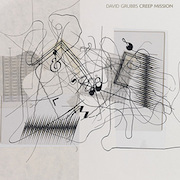In his brilliant 2014 book Records Ruin The Landscape, David Grubbs writes of what he calls the "unfamiliar nexus" that linked pop, jazz and the experimental avant-garde in London in the late 1960s. Grubbs’s own restless career, full of dualities, can be seen as charting its own unfamiliar nexus between disparate contexts and traditions. On one hand, the guitarist and improviser’s music can be highly tuneful, even lush, as on the 17-minute 2011 single ‘The Coxcomb’; on the other he is capable of something as avant-garde and minimal as the same year’s ‘Aux Noctambules’, which is basically 15 minutes of a single chord. He has one foot in academia as a professor at Brooklyn College, yet emerged from the squall of the 1980s hardcore punk scene in Kentucky with the much-loved Squirrel Bait; then he went on to play with 1960s psych crusaders The Red Krayola. If you wanted to, you could describe him as highly postmodern. Either way, he is one of the most adventurous, uncompromising and thoughtful figures on the experimental side of American composition.
Because it is composition that Grubbs does. There aren’t exactly many hooks on Creep Mission, his latest album and the follow-up to the equally engrossing Prismrose. That album featured vocals on just one track – Creep Mission features vocals on none. It’s made up of seven instrumentals that wander, occasionally interact, always intrigue and require multiple – perhaps endless – listens.
Grubbs has again enlisted the similarly kaleidoscopic talent that is drummer Eli Keszler, whose jazz-founded contribution on the supreme title track finds a strange but affecting meeting point with Grubbs’s scuzzy electric guitar. Perhaps surprisingly, given the edgy credentials of these two artists, there is a point in ‘Creep Mission’ where everything ‘drops’, as they say, and rhythm and noise take on a recharged, emphasised, tumbling momentum. It’s among the more conventional moments of the record, but the track is one of breathtaking musicianship that might be bracketed with the more wistfully harmonious side of Grubbs’s oeuvre, and is comparable with the drowsy lo-fi aesthetic of his 2004 album A Guess At The Riddle.
Creep Mission also prioritises harmony, melody and rhythm on the robust ‘Slylight’, while long-time Grubbs touchstone John Fahey is evoked on the acoustic numbers ‘The Bonapartes of Baltimore’ and ‘Jack Dracula in a Bar’. But it is the strangeness of ‘Jeremiadaic’ and ‘Return of the Creep’ that is the heart of the album. ‘Jeremiadaic’ is a soundscape of heavy chimes, scampering percussion and electronic whirrings that continuously stop and start. To listen loudly on headphones is a bewildering experience, like a nightmarish sound bath. ‘Return of the Creep’ is a similar toying with noise. Together, these pieces reflect Grubbs’s love of Cage and Stockhausen, while there is potentially also a comparison with some of the experiments in layering that Luciano Berio made in the 1960s with his sequenzas.
Records Ruin The Landscape is in part about John Cage and others’ dislike of the tyranny of ‘the recording’ and its tendency to shackle avant-garde music to one moment in time, and how this evolving movement was particularly badly served by a recording industry which demanded limits on time and improvisation and could not accommodate important visual components. With ‘Jeremiadaic’ and ‘Return of the Creep’, Grubbs is returning to the question of how to present such expansive and apparently inaccessible sonic art on the traditional format that is an album (although it should be remembered he also releases uncategorisable things such as the aforementioned ‘Aux Noctambules’ and 2002’s 60-minute collaboration project Act Five, Scene One).
And his method works. In presenting his more abstract and experimental pieces alongside familiar stylistic concoctions such as the title track and the raga-influenced closer ‘The C in Certain’, he elevated and illuminates them. They are made all the more exotic because everything around them is at least a bit recognisable – in this setting, sound art takes on renewed focus and assumes perimeters, making it all the more effective and memorable.
Creep Mission is probably not a record that is representative of David Grubbs, because no single release of his can be. It is, however, a typically playful and intellectually ambitious set – and is as good an entry into the world of Grubbs as any.


